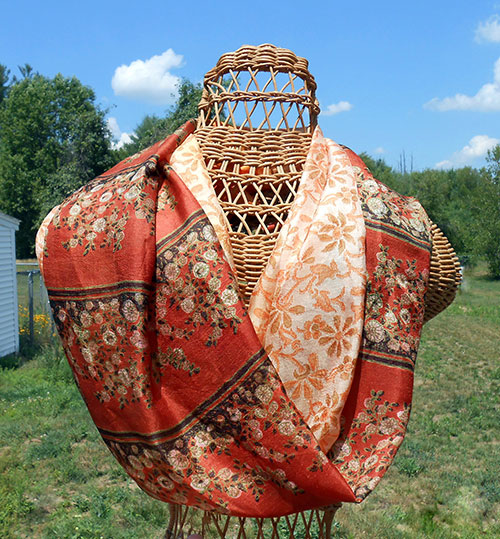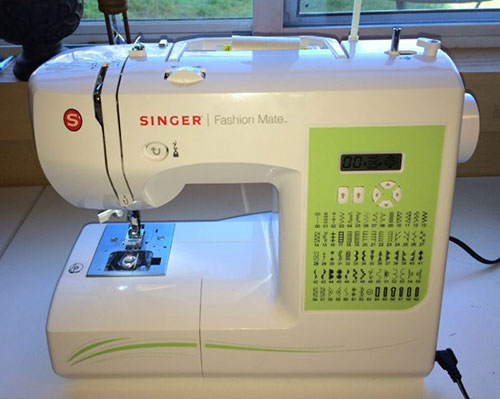Singer Fashion Mate 7256 Review: A Good Sewing Machine for Beginners
The Origin Story
A year ago, I bought this Singer Fashion Mate 7256. It was a daily deal on Amazon for $99, and it was a bit of an impulse buy. The reviews on Amazon seemed fairly good, and I didn't know enough about sewing machines at that point to have strong feelings about the features I wanted or didn't want.
Well, I've been sewing with it for a year now, and I've learned a lot about sewing and sewing machines in that space of time (see my post on things I learned in my first year of sewing). I've also started hording vintage sewing machines to restore, so I have experience with a variety of sewing machines. I feel like I'm in a good place to give a review of this machine's features and limitations. Even though I have six vintage machines, which I love to use, I find myself turning to the Fashion Mate for most of my projects. I have yet to have any major issues with it, and all in all, I think it was a great machine to learn on.
Disclosure: This post contains affiliate links, which means I may receive a percentage if you make a purchase using these links. This won't cost anything extra to you. I only link to things I like and use, and the proceeds help me to run this blog. Thank you for supporting me!
As of writing this in September 2016, the Fashion Mate 7256 is around $160, but I've seen it listed as a daily deal more than once since I bought it, so keep an eye out for lower prices. That said, I think $160 is reasonable, and I would happily pay that if I needed to replace my machine.
What to Look for in a Beginner's Sewing Machine
If you visit sewing forums online, you'll find people who aren't huge fans of modern Singer sewing machines. At a certain point, Singer (and other sewing machine companies) stopped building all-metal sewing machines and started building their machines with plastic gears and computerized components that were bound to fail at some point. Modern machines are not meant to last forever, and they are definitely made with planned obsolescence in mind. Historically, Singer used to insist that you trade in your old machine if you bought a new one, so they could destroy it. They didn't want too many sewing machines on the second hand market. There are sewing machines that are 60-100 years old and still in perfect working condition (or easy enough to get into perfect working condition). You can't open up newer machines and service them as easily as you can with older sewing machines. You can't replace parts as easily. They aren't as heavy duty and rugged as older sewing machines.
Having said all of that, newer machines have features that older machines do not. I think there's a time and a place for both vintage and newer sewing machines. Sewing machine purists will try to convince you that modern Singers are all garbage. It's true that they're not as durable as old Singers, but that doesn't mean you shouldn't get one. The same can be said of modern phones or modern vacuum cleaners, or virtually any piece of technology. They're not as durable as they once were, but they have features that older technology doesn't have.
With older machines, I sometimes worry about whether the electrical components are still safe. I haven't gotten into rewiring them (yet). This is something you don't have to worry about with new machines. Threading is often a little simpler with new machines (though some will argue that tension is better with a more elaborate thread path). New machines usually have more stitch options and computerized features than old machines, which can be handy.
I mention all of this because I've seen people ask about getting their first sewing machine in online forums, and sometimes the commenters overwhelmingly recommend getting a vintage/antique machine. My experience suggests that it's easier to learn on a modern sewing machine and then get into vintage machines. I've also seen lots of people recommend that you get the most expensive modern machine that you can afford. You will probably have to upgrade your modern sewing machine at some point because it won't last forever, but then again, that means that it's fine to get a cheaper machine to learn on and trade up if it turns out you really like sewing. If you don't like sewing, you won't feel bad for having wasted money on a really expensive machine. One last point: I've seen a lot of commenters recommend trying your machine out in person before buying. While I'm sure this is ideal, it's not always feasible, and I didn't have any issues buying mine online. Amazon is also very good about taking returns, so I wouldn't worry too much about buying your sewing machine online.
Why I like the Singer Fashion Mate 7256
So what is it about the Singer Fashion Mate 7256 that makes it a good beginner machine? I think it has a good balance of bells and whistles, while still being fairly simple to use. It comes with a DVD that shows you everything you'll need to know about it, from threading to filling bobbins to using more specialized features. As a complete beginner, I was able to get it up and running without too much trouble. It was nice to be able to see it in action and see close ups of how to do things. The manual is very helpful and detailed as well, and I learn something new every time I go back to it. It explains what every stitch can be used for and gives tips on how to get the best results.
After a year of pretty intensive sewing with a lot of different fabrics, needles, and threads, it's still going strong. I've had no more than minor issues, most of which I probably caused myself due to my own inexperience.
It has an automatic needle threader, which is nice. You can move your needle position (left or right) at the press of a button. There are 70 different stitches that you can choose from, which can be adjusted in terms of length and width. The bobbin plate is see-through, so you can easily monitor how much thread is left. It comes with several presser feet and a buttonhole foot. Buttonholes are easy and fast to do, and there are a number of built-in options. It doesn't have a programmable up/down option for the needle, but if you upgrade to the 7258 for about $10, you can get that option.
I haven't run into anything that it wouldn't sew, including a few layers of vinyl. The stitches are nice and even. I haven't had any issues with skipped stitches, thread tension, or thread tangling. Hold onto the thread ends when you first start sewing, or you may get a little bit of a "bird's nest" under your fabric. This is true of most machines.
Most low shank presser feet will work with it. I've bought a variety, including Singer brand and other brands. It takes standard sewing machine needles and size 15J bobbins. It came with a package of needles, a bobbin, a little screwdriver to help you with routine maintenance, a brush to help you clean out lint, and a darning plate for when you need to disengage the feed dogs.
It has a free arm, which means that you can remove the storage compartment in the front to more easily sew a circular piece, such as a sleeve or cuff without having to maneuver it awkwardly. Most vintage sewing machines do not have free arms, and it's a feature I use often.
You can easily do simple sewing with this sewing machine and also do more complicated projects. It doesn't have every feature out there, but it offers a lot of options for a beginner.
Troubleshooting/Issues
- You can't set your stitch length to zero with a straight stitch, but you can choose a decorative stitch and hit the backstitch button to sew several stitches in place to secure your threads.
- The bobbin winder is sometimes a little finicky, at least on my machine. Hold onto the long tail from your bobbin the whole time you're winding, and don't stop winding partway through. Sometimes the bobbin will get "stuck" (i.e., won't have enough traction to keep winding thread onto the bobbin) if you stop and start. Put your thread on the horizontal spool pin and use a spool cap.
- The automatic needle threader will only work when your needle is in the highest position. This isn't really an issue with the machine, but I didn't realize this for awhile, and I thought the threader wasn't working!
Conclusions
I really like this sewing machine. I've successfully completed a lot of projects with it, and it has yet to let me down. I'm sure I'll upgrade to something fancier at some point, but I'm in no hurry to do so.













